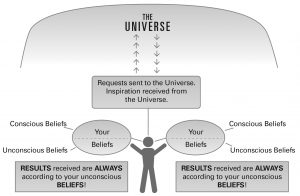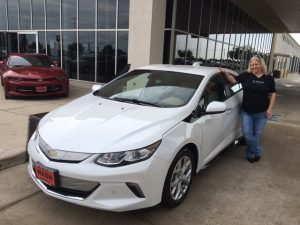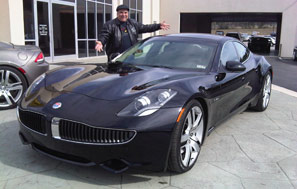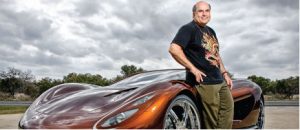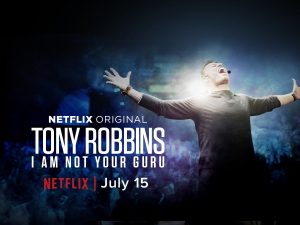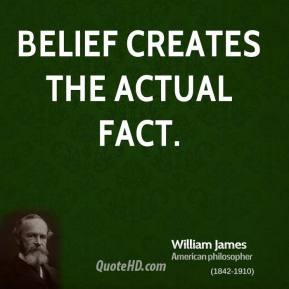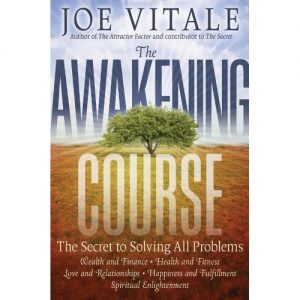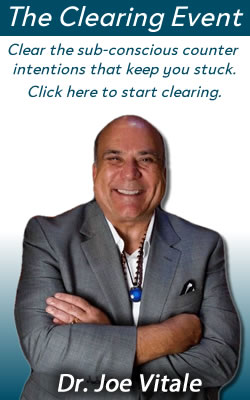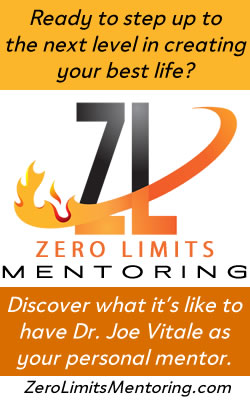Dr Joe Vitale
When LOA Fails
I know you might be one of those people who feel like the Law of Attraction just doesn’t work for you.
I understand and I want to help.
So let’s begin…
Have you ever had one of those days where gravity wasn’t working for you?
Where you can’t seem to keep your feet planted on the ground and you wind up floating around in the atmosphere?
Of course not.
Why not?
Because gravity is a LAW.
It doesn’t work some days and not work other days.
It’s *always* working, and you are experiencing the effects of it all the time, at every moment.
Even right now.
But you probably never spilled a cup of coffee and said, “Darn that Law of Gravity!”
Instead, you realized it was your actions coupled with the existing law that caused the accident.
Well, the Law of Attraction is exactly the same.
It’s a LAW – not a feel-good principle or some kind of new-age voodoo flake-out.
You can’t “do” the Law of Attraction wrong.
It doesn’t turn off and on, like a light switch.
It’s not subject to fate or fancy.
It is a powerful but neutral force that is constantly operating.
Just like gravity.
And that means something extremely important –
It means that what you have right now (or don’t have right now) is – on some level – exactly what you want.
The good stuff and the bad stuff.
The abundance and the lack.
You’ve attracted all of it.
Why?
How?
Because your conscious thoughts aren’t all there is.
Below the surface, a complex and deep-seated collection of beliefs are exerting an extremely powerful force in your life.
When these subconscious thoughts are in harmony with what you consciously intend, you attract it.
But if there are “counter-intentions” present within you – that is, thoughts and beliefs that run contrary to your conscious wishes – you will not achieve the results you want, no matter how much you want them on the surface.
This is not cause for blame or guilt.
After all, you weren’t aware of the unconscious beliefs working.
What this is all about is awakening.
I’m probably the only teacher in the movie The Secret that has stood my ground about this.
I’ve taken heat for it, too.
I feel like Freud when he introduced his idea of the unconscious mind in the late 1800s and was booed off stage.
He didn’t back down.
Neither have I.
So how do you get clear of those contrary beliefs within your unconscious mind?
How do you get rid of the inner roadblocks and go warp speed ahead, right to whatever it is you’re trying to achieve or attract?
It took me some time to figure out the answer to that question.
But once I did, it was as if all the limits in and around me shattered.
I thought life was good before – I had no idea it could be THIS good.
I thought I’d achieved a pretty high level of personal and professional success – but the success I experienced once I got clear absolutely blew me away.
I had finally discovered –
“The Missing Secret” that makes the Law of Attraction work the way you want it to – 100% of the time.
There are two ways you can learn this “Missing Secret.”
1 – Get my Nightingale-Conant bestselling audio program. http://www.nightingale.com/missing-secret.html
2. – Get in my famous Miracles Coaching program. http://www.MiraclesCoaching.com
Obviously, the coaching program will require a bigger investment, but the results will be dramatic and fast.
But I understand if you’d rather invest in the audios and listen and awaken at your own pace.
Either way, the choice is yours.
Which will you choose?
Ao Akua,
PS – Consider: If the Law of Attraction is already working but you aren’t seeing the results you want because you don’t understand it yet, how much more incredible will your life be once you use the Law with conscious intention and crystal clarity? As I often say, “Expect Miracles.”
Here’s your choice:
1 – Get my Nightingale-Conant bestselling audio program. http://www.nightingale.com/missing-secret.html
2. – Get in my famous Miracles Coaching program. http://www.MiraclesCoaching.com
Attracting Electric Cars
My wife, Nerissa, drives the Chevy Volt and loves it. She’s had it since 2012. Her electric car never fails, always looks great, contains what feels like enormous room inside, and rides smooth on our errands and trips. It’s a great car.
It’s so great that we just went and traded it in for a brand new 2017 Chevy Volt.
But not all electric cars are so cool or so reliable.
I owned the Fisker Karma a few years ago.
It was the opposite.
It was a nightmare to drive, though it was stunningly beautiful.
There were over a dozen things wrong with it, and the company.
Eventually the company went bankrupt, and I sold the car at a big loss.
Of course, Tesla is all over the news.
I called them when they announced their limited edition of 100 Roadsters around 2008.
But Tesla talked me out of buying one, saying they didn’t have service stations in Texas and wouldn’t be able to repair my car without transporting it to California or sending a technician to me.
Good thing I passed on that roadster, as even Elon Musk today admits that his first car was a disaster.
In a June 2016 Road and Track article online, Musk was reported as saying they had “no idea what we are doing,” and characterizing their original efforts as “completely clueless.”
Tesla is still getting lots of the media attention and I’m glad to see it.
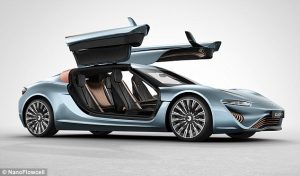
This German marvel runs on salt water, gets 960 hp and 373 miles to the tank, but will it ever be made?
Tesla’s new cars look hi-tech, dependable, and safe.
But I live in Texas, where I have seen the car on the road but have never test driven one. (I asked for a test drive and so far, over three weeks later, no one has replied.)
Besides, I’m not all that keen to get into another electric car, given my trauma with the Fisker.
And the most recent news was of a man killed while using the auto driving feature on his Tesla.
Apparently, the long range electric sports car is not yet out of the woods.
But all of this got me wondering about the origin of the electric car.
In an episode of Jay Leno’s great new TV show, Leno’s Garage, he drove an electric car from the early 1900’s that could get 90 miles on a charge.
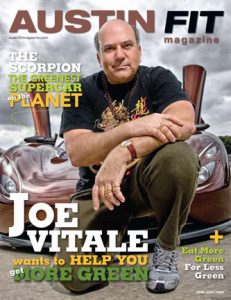
I promoted and invested in the Ronn Motors Scorpion, a stunning hydrogen sports car, only to see the company go bankrupt
What happened to it?
What happened to all the other early electric cars?
So I did some research.
Turns out in the late 1800s and early 1900s, the most popular car was the electric.
There were steam driven cars, which no one liked, and a few gas driven cars, which no one knew how to drive or fix.
But people were ready for something new, as the feces and urine filled streets where horse drawn carriages turned the roads into a sewer of slosh, was just too much and too unsanitary.
The electric was clean, dependable, and smart.
Or course, there were few cleared roads then.
And no driving schools.
And no battery chargers.
And few people had electricity.
And even fewer could actually afford the much more expensive electric car.
And a single battery cost more to replace than the Model T would cost to own.
For example, the price of a Detroit Electric car in 1914 was about $2,650. If you wanted to upgrade to the Edison Nickel Iron batteries, then the price went up about $600. At the same time, you could buy TWO NEW Model T’s for that same $600. (!)
It was an uphill battle for the electric car.
Of course, many tried to make it work.
Some entrepreneurial companies saw a business in an electric car taxi service.
The problem was, the cars could only drive about 10 miles before needing a charge or a battery replacement.
This was an incredible nuisance for the passenger — you could only go 5-10 miles away (!) – as well as for the driver and not to mention the cab company.
As a result, electric cars were made, but they weren’t sold easily: first because they were too expensive to buy, and second, they were too expensive to keep replacing batteries.
Most of the electric car companies went bankrupt.
And then Henry Ford enters.
Ford actually wanted to invest in the electric car, and make them.
He bought an electric car every other year for years. He and his wife loved them.
But the electric car companies created a coalition to block any competitors they didn’t like.
In short, many electric car companies got greedy and tried to create a monopoly.
Ultimately, they drove themselves off the pages of history.
The electric car simply wasn’t convenient or affordable at the time, and many electric companies were ruthless and competitive.
But that’s not all that happened to make the electric car lose power.
Thomas Edison inspires Henry Ford
It was actually Thomas Edison who threw the switch on making the gas powered car the vehicle of choice.
Edison, the king of all things electric, met Henry Ford at a now historic dinner in 1896.
The inventor listened to the car creator describe his idea of an ideal car: affordable, dependable, efficient, and requiring almost no maintenance.
In fact, Ford wanted his car to be low priced and maintenance free.
Edison heard all of this and slammed the table with his fist.
He then said these now historic words to Ford –
“Young man, that’s the thing; you have it. Keep at it. Electric cars must keep near to power stations. The storage battery is too heavy. Steam cars won’t do, either, for they require a boiler and fire. Your car is self-contained—carries its own power plant—no fire, no boiler, no smoke and no steam. You have the thing. Keep at it.”
Ford listened.
As a result, Ford moved the world with his new car, which was a public hit.
The electric car drifted out of awareness, except for a few failed attempts over the decades at resurrection, and the fossil fuel driven car won the race.
By 1919, virtually all electric car production was stopped, and the electric began to fade away.
It wouldn’t be until the 1970s, when gasoline prices hit record highs, that the mass public started to look for an electric car again.
I’m joining in that search.
A decade ago, when I met the people who make Panoz race cars (I have two of their street legal beauties), I told them if they make an environmentally friendly sports car, I’d buy it.
They haven’t yet.
When I heard of Ronn Motors inventing a hydrogen driven sports car, I ordered the first one, bought stock in the company, invested in the company, promoted the car on national television and on the front page of local magazines.
The company went bankrupt.
When I heard of a sports car that could run on sea water, I contacted the German company and asked if I could invest in it and order a car.
No one answered.
When Porsche made a one-of-a-kind 918 Spyder electric hybrid sports marvel, I asked the price.
They said $845,000. I passed (and almost passed out).
When BMW (a car maker I’ve always loved), developed the electric hybrid sports car they called the i8, I ordered one.
But after half a year of waiting, the salesman said it would be three more years before I would get my car.
I cancelled my order.
I could go on.
Today the marketplace is ready for an electric (or solar or sea water or any environmentally safe) car that is affordable, dependable, convenient, and attractive.
Tesla is working in that direction.
I’ll keep watching them, and other auto makers like Audi, Acura, and Nissan, to see who wins the next race. I may be a specialist in how to attract a new car, but the car also has to exist. 🙂
Meanwhile, we now have Nerissa’s 2017 Chevy Volt.
Let’s charge up and go!
Ao Akua,
PS – Some of my resources for this post include —
https://www.amazon.com/History-Electric-Cars-Nigel-Burton/dp/1847974619/
http://www.autoblog.com/2010/05/24/milburn-unveiled-1-000-ev-with-100-mile-range-swappable-batter/
http://www.lowtechmagazine.com/overview-of-early-electric-cars.html
http://aetherforce.com/electric-car-powered-by-salt-water-920-hp-373-milestank/
http://www.autobytel.com/hybrid-cars/car-buying-guides/best-electric-sports-cars-128503/
Non-Guru Tony Robbins
Three times.
That’s how many times I’ve watched the Netflix documentary, Tony Robbins: I Am Not Your Guru, which was released on July 15, only days ago.
I’m in the movie The Secret and I haven’t watched that film three times in ten years.
So why am I so captivated with this film about Tony?
It’s raw but real.
Hard-hitting but healing.
Profane but profound.
I found myself crying throughout it.
I found myself having internal breakthroughs just watching it.
I found myself relating to Tony’s inspired approach to change.
The film captures Tony’s closed-door week-long event called Date with Destiny.
In some ways the event reminded me of the old Werner Erhard est program, and to today’s Landmark Forum.
This film puts you in Tony’s secret space, much like Luke Rhinehart’s The Book of est puts you in an est event.
In both cases, you can safely observe the sometimes rollicking emotions people experience.
And in both cases, you can experience transformation just by going for the ride.
All you have to do is pay attention and feel.
Oh, there are holes in the movie.
Tony says change happens in a moment.
Yet later in the film, when he’s asked how he changed, he says there was no one moment.
Tony comes across as the trigger for change and not any method or principle.
Yet if Tony is needed for change, then methods don’t exist; there is no method. It’s him.
But I’m not a critic of the film; I’m a fan.
That’s why I’ve seen it three times – so far.
I let any holes or inconsistencies slide by as I focus on the good in the movie, the breakthroughs, the insights, the energy, the sharing – all of which act as a catalyst to awaken viewers who aren’t even physically in the seminar room with the giant king gorilla.
This makes the film itself a tool for transformation.
Documentary filmmaker Michael Moore told Joe Berlinger (the director of this film on Tony), “I believe it will actually save lives.”
I believe it, too.
A few more reasons why I love the film –
Tony goes past the little problems people offer and goes deeper, to the operating system under what they present.
When a 19 year old says her problem is her diet, Tony digs deeper to discover her issue is with her father, not her diet.
The movie helps prove why we all need coaching; without a trained person’s objective feedback, we will continue to blame our problems on others or on little things and entirely miss the big hidden operating system below our conscious awareness.
And I love statements such as, “You know what your biggest problem is? Thinking you shouldn’t have any.”
Tony goes on to explain that problems are gifts.
I don’t know Tony personally — we spoke at the same event in Chicago years ago, but hours apart, so we have yet to meet* — and I get nothing for endorsing this film from him or the director or anyone else.
But I urge you to watch it and let it stir your soul.
See https://www.netflix.com/title/80102204
Expect Miracles.
Ao Akua,
PS – My own television show, all fourteen episodes, is edited and in the hands of Amazon. Stay tuned for details. Meanwhile, go watch the film about Tony Robbins: I Am Not Your Guru. It’s stirring, soulful and spellbinding.
* You can read about the event where I spoke on the same stage as Tony, Trump, and others at http://blog.mrfire.com/a-tony-robbins-first/
Mind Dancing
Your mind is incredible.
It can lead you to happy thoughts and right actions….
Or…
…or it can lead you to dark thoughts and actions you may regret.
I call it “Mind Dancing” because that’s what it does: dance around like a monkey chasing a fly in a forest.
Obviously, you need to have better control of your mind in order to attract and achieve your goals and dreams.
You need to learn how to “lead” the mind dance.
But how?
I’ve had customers tell me the single most powerful course I’ve ever made is called “The Awakening Course.”
Go through it and you’ll have a better handle on the Mind Dance and you’ll discover methods to help you awaken from the trance of scarcity, lack, and limitation.
This course is deep but easy to understand, and it takes you from beginning to advanced in spiritual development.
Here’s just a sample of what you will discover in “The Awakening Course“…
- – What it means to be awakened and why it’s so important
– How you can create your own awakened life filled with miracles
– The steps to get out of the victim mentality
– Ways to turn your fears into catalysts for success
– How to move beyond ego
– 5 steps for attracting anything or anyone into your life
– The missing secret for making the Law of Attraction work every time
– How the universe works (the real truth)
– Cleaning and clearing methods allowing miracles
– New perspectives on money and the power of your unconscious
– How to re-state complaints into positive life-changing intentions
– The role gratitude plays in attracting what you want in your life
– How to co-create with the Divine
– A rare ancient method you can use to clear inner blocks
– How to prepare yourself to become awakened
And much more, of course.
I truly believe the time is right for you to go check this out today.
You’ll love the stories, processes, insights, tools and more.
“The Awakening Course” is available in a variety of formats for you to choose from —
As a set of audio CDs delivered to your door: http://www.theawakeningcourse.com/
As an immediate audio download of the entire course: http://www.awakeningdownload.com/
As a printed book or as an e-book for your Kindle reader: https://www.amazon.com/Awakening-Course-Secret-Solving-Problems/dp/1118148274
Expect Miracles.
Ao Akua,
PS – Skeptical? I don’t blame you. But don’t let your “Mind Dancing” talk you out of your own good. Take charge of your mind and direct it to your next step in awakening. Consider —
Some famous spiritual leaders said (about the book version of The Awakening Course) —
“This exciting and empowering book guides one and all through the exhilarating process of awakening. Not to be missed.” — Sonia Choquette, New York Times bestselling author of The Answer Is Simple
“I love how Joe easily explains the stages of awakening and offers practical ways to experience them. This is an enlightening book.” — John Gray, author of Men Are from Mars, Women Are from Venus
“I know Joe Vitale and love this book. It provides solutions to our problems by awakening to the stage above them. He’s brilliant!” — the late Debbie Ford, author of The Dark Side of the Light Chasers
Remember, “The Awakening Course” is available in a variety of formats —
As a set of audio CDs delivered to your door: http://www.theawakeningcourse.com/
As an immediate audio download of the entire course: http://www.awakeningdownload.com/
As a printed book or as an e-book for your Kindle reader: https://www.amazon.com/Awakening-Course-Secret-Solving-Problems/dp/1118148274
Extreme Ownership
The other day I went to a local Sprint phone store to get a newer modem.
As it turned out, a miracle happened.
Since I’ve been a Sprint customer for more than ten years, I have a collection of modems that are now prehistoric. I once took a few of them to the store and the clerks took pictures of them. They had never seen the old models. They were like dinosaurs to them.
So I picked up a new and improved whiz-bang latest greatest modem and drove off.
At home, I realized that the modem didn’t have a power cord.
Apparently I had left it at the store.
Dismayed, I called the store and asked for the clerk who waited on me.
“This is Angie,” she said, brightly.
“Angie, I think I left –”
“You left the power cord here!” she interrupted, remembering me. “I forgot to put it in the box.”
I started to complain about how this would require me leaving my home again and making another drive back to the city. I wasn’t looking forward to it, as the store isn’t right around the corner. I live in the Hill Country, not the city. Plus I keep a busy schedule.
But before I could say much of anything, Angie interrupted me.
“I’ll bring it to you,” she said.
I was stunned.
I was speechless.
I was quiet for a moment while I replayed what I heard in my mind, not believing it.
“You’ll bring it to me?” I asked. “I don’t live near you, you know.”
“It’s okay,” she said. “It’s my fault and I’d be glad to drive it to you right after I get off work today.”
She did, too.
She was all smiles as she handed me the cord at my house.
“Do you live out here someplace?” I asked.
“No, but don’t think anything of it,” she said. “It was my choice.”
Angie’s astonishing customer service and upbeat attitude got me thinking about a book one of my nephews told me about.
Extreme Ownership is a New York Times bestseller by Jocko Willink and Leif Babin.
It explains the leadership skills of the U.S. Navy Seals. It’s a well written book, with stories from the military as well as business, with principles they teach to get stellar results.
What interested me was the idea of full – or extreme – responsibility.
In my books, Zero Limits and AT Zero, I talk about total responsibility as a principle of ho’oponopono.
But Extreme Ownership strips away the spirituality and explains “extreme responsibility” as a practical tool in business and life.
I have no idea if Angie read Extreme Ownership, but her instant willingness to satisfy her customer reflected an attitude of total responsibility.
She didn’t pass the buck.
She didn’t tell me to drive back in.
She didn’t complain or blame or refrain.
She took responsibility.
She took extreme ownership.
And she has a friend, a fan, and a fanatic customer for life.
How does this apply to you?
Whenever you are about to complain that someone didn’t do something you asked for, turn it around and claim “extreme ownership” for the problem.
Look in the mirror and accept responsibility for your own lack of communicating how important the job was.
Look to yourself for your lack of leadership skills.
And then do something to correct it.
The other night I watched a brief biography of President John F. Kennedy.
When the Bay of Pigs was a disaster in 1961, and soldiers lost their lives, Kennedy went on national television and accepted total responsibility for the tragedy.
You may not be president, but you ask people to do things and they often don’t do them.
Are you going to blame them or find a way to resolve the issue?
Extreme ownership – whether taught by the U.S. Navy Seals or the practiciners of ho’oponopono – is about taking full responsibility and fixing the problem from within you.
Of course, at a certain point, you may decide to remove the people who aren’t doing what they promise, no matter how many times you explain it or in so many different ways.
That’s when you need to pull a Donald Trump and say, “You’re fired!”
But that decision only comes after exhausting your alternatives and taking extreme responsibility for the results – or lack of them.
As my new motto states, “It is what you accept.”
What are you accepting?
Ao Akua,
PS – Have you read my new book?

